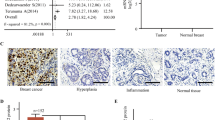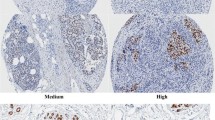Abstract
Background
Transgelin-2 is an actin-binding protein that is widely expressed in various tissues and organs of the body, and reportedly may participate in the development and progression of multiple cancers. However, the clinical significance of transgelin-2 still remains controversial. We, therefore, aimed to determine the expression of transgelin-2 in breast cancer as well as its correlation with the tumorigenesis, progression and prognosis of human breast cancer.
Methods
We collected tissues of 58 breast cancer patients from our hospital and 1090 samples from The Cancer Genome Atlas (TCGA) database. X-tile software was used to divide the transgelin-2 mRNA expression level in the database, logistic regression model was used to identify independent factors influencing transgelin-2 mRNA expression, and then Cox regression and Kaplan–Meier analysis were used to find factors that influence survival of breast cancer.
Results
Transgelin-2 was significantly overexpressed in breast cancer tissues from our hospital and receiver operating characteristic (ROC) curve indicated that transgelin-2 may have diagnostic value. Meanwhile, estrogen receptor (ER) was in inverse correlation with transgelin-2 protein and mRNA expression, and transgelin-2 expression was positively correlated with Ki67 in breast cancer tissues. Logistic regression model revealed that TNM stage, ER and progesterone receptor (PR) status were independent factors for transgelin-2 mRNA expression. Patients with high transgelin-2 mRNA expression showed a poor survival and the trend was statistically significant only in ER-negative patients.
Conclusions
Transgelin-2 was expressed significantly higher in breast cancer cells and correlated with some clinicopathological factors. High transgelin-2 expression might predict poor prognosis for ER-negative patients.




Similar content being viewed by others
References
Torre LA, Bray F, Siegel RL, Ferlay J, Lortet-Tieulent J, Jemal A. Global cancer statistics, 2012. CA Cancer J Clin. 2015;65(2):87–108.
Chen W, Zheng R, Baade PD, Zhang S, Zeng H, Bray F, et al. Cancer statistics in China, 2015. CA Cancer J Clin. 2016;66(2):115–32.
Lin B, Zhang L, Li D, Sun H. MED23 in endocrinotherapy for breast cancer. Oncol Lett. 2017;13(6):4679–84.
Salatino M, Girotti MR, Rabinovich GA. Glycans pave the way for immunotherapy in triple-negative breast cancer. Cancer Cell. 2018;33(2):155–7.
Reinert T, Goncalves R, Ellis MJ. Current status of neoadjuvant endocrine therapy in early stage breast cancer. Curr Treat Options Oncol. 2018;19(5):23.
Bai F, Yin Y, Chen T, Chen J, Ge M, Lu Y, et al. Development of liposomal pemetrexed for enhanced therapy against multidrug resistance mediated by ABCC5 in breast cancer. Int J Nanomed. 2018;13:1327–39.
Baguley BC. Multiple drug resistance mechanisms in cancer. Mol Biotechnol. 2010;46(3):308–16.
Na BR, Kim HR, Piragyte I, Oh HM, Kwon MS, Akber U, et al. TAGLN2 regulates T cell activation by stabilizing the actin cytoskeleton at the immunological synapse. J Cell Biol. 2015;209(1):143–62.
Koudelkova P, Costina V, Weber G, Dooley S, Findeisen P, Winter P, et al. Transforming growth factor-beta drives the transendothelial migration of hepatocellular carcinoma cells. Int J Mol Sci. 2017;18(10):2119.
Elsner M, Rauser S, Maier S, Schone C, Balluff B, Meding S, et al. MALDI imaging mass spectrometry reveals COX7A2, TAGLN2 and S100-A10 as novel prognostic markers in Barrett’s adenocarcinoma. J Proteom. 2012;75(15):4693–704.
Zhang Y, Ye Y, Shen D, Jiang K, Zhang H, Sun W, et al. Identification of transgelin-2 as a biomarker of colorectal cancer by laser capture microdissection and quantitative proteome analysis. Cancer Sci. 2010;101(2):523–9.
Chen CL, Chung T, Wu CC, Ng KF, Yu JS, Tsai CH, et al. Comparative tissue proteomics of microdissected specimens reveals novel candidate biomarkers of bladder cancer. Mol Cell Proteom. 2015;14(9):2466–78.
Yakabe K, Murakami A, Kajimura T, Nishimoto Y, Sueoka K, Sato S, et al. Functional significance of transgelin-2 in uterine cervical squamous cell carcinoma. J Obstet Gynaecol Res. 2016;42(5):566–72.
Hill JJ, Tremblay TL, Pen A, Li J, Robotham AC, Lenferink AE, et al. Identification of vascular breast tumor markers by laser capture microdissection and label-free LC–MS. J Proteom Res. 2011;10(5):2479–93.
Yoshida A, Okamoto N, Tozawa-Ono A, Koizumi H, Kiguchi K, Ishizuka B, et al. Proteomic analysis of differential protein expression by brain metastases of gynecological malignancies. Hum Cell. 2013;26(2):56–66.
Chen S, Dong Q, Hu S, Cai J, Zhang W, Sun J, et al. Proteomic analysis of the proteins that are associated with the resistance to paclitaxel in human breast cancer cells. Mol BioSyst. 2014;10(2):294–303.
Zheng X, Chen S, Yang Q, Cai J, Zhang W, You H, et al. Salvianolic acid a reverses the paclitaxel resistance and inhibits the migration and invasion abilities of human breast cancer cells by inactivating transgelin 2. Cancer Biol Ther. 2015;16(9):1407–14.
Cai J, Chen S, Zhang W, Zheng X, Hu S, Pang C, et al. Salvianolic acid A reverses paclitaxel resistance in human breast cancer MCF-7 cells via targeting the expression of transgelin 2 and attenuating PI3 K/Akt pathway. Phytomedicine. 2014;21(12):1725–32.
Cai J, Chen S, Zhang W, Hu S, Lu J, Xing J, et al. Paeonol reverses paclitaxel resistance in human breast cancer cells by regulating the expression of transgelin 2. Phytomedicine. 2014;21(7):984–91.
Xu SG, Yan PJ, Shao ZM. Differential proteomic analysis of a highly metastatic variant of human breast cancer cells using two-dimensional differential gel electrophoresis. J Cancer Res Clin Oncol. 2010;136(10):1545–56.
Ma J, Kong Y, Nan H, Qu S, Fu X, Jiang L, et al. Pleiotrophin as a potential biomarker in breast cancer patients. Clin Chim Acta. 2017;466:6–12.
Penault-Llorca F, Radosevic-Robin N. Ki67 assessment in breast cancer: an update. Pathology. 2017;49(2):166–71.
Yerushalmi R, Woods R, Ravdin PM, Hayes MM, Gelmon KA. Ki67 in breast cancer: prognostic and predictive potential. Lancet Oncol. 2010;11(2):174–83.
Acknowledgements
We thank Hongyan Wang, Department of Pathology, The First Affiliated Hospital of Xi’an Jiaotong University, Xi’an, China, for the assistance in collecting tissues sections.
Funding
This study was funded by the National Natural Science Foundation of China (grant number 81473177 and 81672954) and Shaanxi province key research and development program (grant number 2017SF-089)
Author information
Authors and Affiliations
Corresponding author
Ethics declarations
Conflict of interest
By collecting the conflict of interest disclosure forms of all authors, the authors declare that they have no conflicts of interest.
Ethical approval
All procedures performed in studies involving human participants were in accordance with the ethical standards of the institutional and/or national research committee and with the 1964 Helsinki Declaration and its later amendments or comparable ethical standards. This article does not contain any studies with animals performed by any of the authors.
Informed consent
Informed consent was obtained from all individual participants included in the study.
Additional information
Publisher's Note
Springer Nature remains neutral with regard to jurisdictional claims in published maps and institutional affiliations.
Electronic supplementary material
Below is the link to the electronic supplementary material.
About this article
Cite this article
Hao, R., Liu, Y., Du, Q. et al. Transgelin-2 expression in breast cancer and its relationships with clinicopathological features and patient outcome. Breast Cancer 26, 776–783 (2019). https://doi.org/10.1007/s12282-019-00981-4
Received:
Accepted:
Published:
Issue Date:
DOI: https://doi.org/10.1007/s12282-019-00981-4




